The Boy I Like? is the English translation of a freeware doujin Japanese visual novel by circle 1010 named Ki ni Naru Otoko no Ko? It is a short comedic piece that I would describe as more of a meme novel than a serious project.
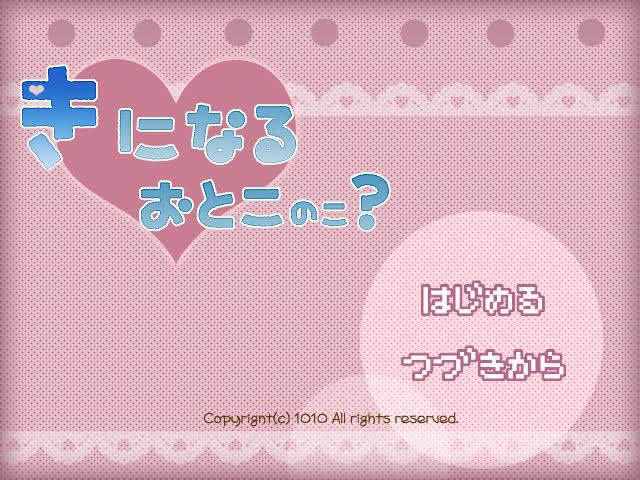
The player takes the role of a naive, love-struck schoolgirl named Mofuko Shizuki. Based on the player’s choices, she has one of three strange love interests. 1010 created a successor novel titled Suki na Otoko no Ko?, but this review will only look at the first entry in the series.
Visual Novel Details
Original Japanese Novel
- Title: Ki ni Naru Otoko no Ko
- Creator: 1010
- Original Release: April 1, 2010
- Engine: NScripter
- Official Download: Freem!
English Patch
- Title: The Boy I Like?
- Translator: kudaratan
- Original Release: December 20, 2014
- Engine: ONScripter-EN
- Official Website: Kudaratan’s Wonderland
- Unshortened Patch DL Link: MediaFire
1010 released a sequel game on November 23, 2014. That game too is free to download and there is an unofficial patch (links and information available on Visual Novel Database). Note, however, that I have not tried the sequel and this review is only of the first game.
Running The Boy I Like? patch
The official website for the patch contains good instructions for getting everything up and running. However, some of the instructions are outdated – so I will write my own up-to-date version with an explanation of how I got things working on Linux. I will include notes about running on Windows or pre-ARM MacOS where applicable. Note that my understanding is that it will most likely not work natively on Macs with ARM CPUs but that may change in the future when more progress is made porting ONScripter-EN to modern Macs.
Steps
Because the English version of The Boy I Like? is a patch, you will need to download the Japanese game. When the patch guide was written, 1010 hosted the download for Ki ni Naru Otoko no Ko. However, the game is now hosted on Freem!, a popular Japanese game download repository that hosts many of the original Japanese novels that I have reviewed as part of my al|together project. Go to the Freem! page for Ki ni Naru Otoko no Ko and download the novel.
Next, we will need the patch. The localizer used a link shortener to the MediaFire download page that I found to be temperamental. However, the actual download is hosted on MediaFire just like it was when the patch was first made available in 2014. I direct you to two versions of the original download link:
The original MediaFire link works but I archived the MediaFire page and download link for preservation purposes, so that should suffice as a fallback.
The patch does not come with ONScripter-EN, which is needed to actually run the novel. The link provided on the patch website no longer works. I refer you to two sources for obtaining the interpreter:
The first link points to the newest versions of ONScripter-EN and includes binaries for Linux and Windows. The second link has links to older versions of ONScripter-EN, including for Mac OS X. There have been limited cases in which I have had to use the older 2011 Linux binary for a game to work correctly. However, in the case of The Boy I Like?, there was no difference in Linux compatibility between the new 2023 ONScripter-EN release and the 2011 one, so I recommend using the first link unless you run into unexpected behavior or are looking to run the novel on an Intel Mac.
Now that you have download the original Japanese novel, the English patch, and the relevant version of ONScripter-EN, you can follow steps 3 and 4 on the official website page for the patch (archived link). These instructions worked without issue for me so I see no need to repeat them here. In short, you must copy the files from the unzipped patch directory into the unzipped Japanese game directory and overwrite two files in the Japanese game directory when prompted. Then add the relevant version of ONScripter-EN to the directory and run the game.
Note for reference that I ran the novel on Linux using the June 28, 2023 ONScripter-EN build for Linux. I have not tested it on Windows (including running the Windows version on top of WINE) but I see no reason why there should be any issues.
Title and Ending Screen Technical Issues
I had one technical issue running the novel on Linux that you can see in my screenshot of the title screen at the top of the article. For whatever reason, the title screen was not translated for me. I was unsure whether this was the expected behavior, but the official website for the patch shows the title screen text in English – so I assume it was some sort of bug or minor issue on my end. I am unsure whether it had anything to do with my running the Linux ONScripter-EN binary instead of Windows (the patch creator states in comments that he or she tested on Windows). I also had the same issue with text displayed in the novel’s seven ending cards.
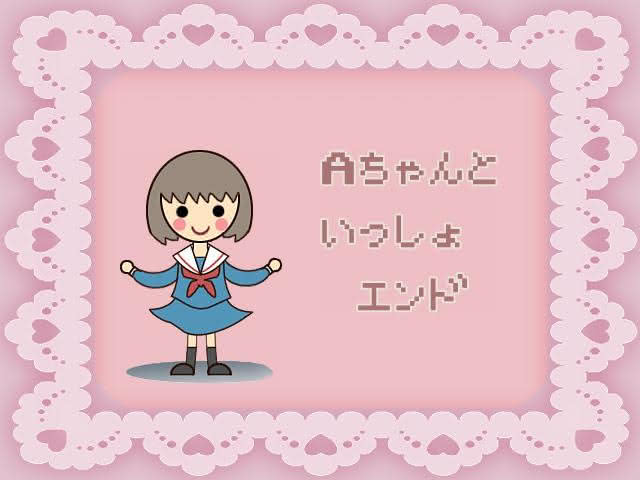
In any event, I describe this as a minor issue because everything else – including menu text – appeared in English. The start menu only has two options – the top to start and the bottom to load – so the title screen and a few of the ending cards not being translated on my end proved to be no impediment to reading the novel.
If anyone with more ONScripter-EN knowledge has a guess as to what happened – send me an email with the information and I will update the article with credit if the email diagnoses the issue.
Note on the Translation Effort
The translator noted that the English patch was sanctioned by 1010:
[I] was granted permission to make an [E]nglish patch of the game as long as [I] had people download the game from the original website.
I thought it was notable that the English patch was sanctioned by the original creator, which makes it similar to many of the al|together localization projects – including the famous 2005 localization of Narcissu. However, there is no indication that the original Japanese creators of the novel participated beyond setting the parameters for the distribution of the English patch as we saw in some other localizations such as True Remembrance and Shooting Star Hill.
Review of The Boy I Like?
Translator kudaratan recommended playing the novel – which he or she describes as “definitely comedy” rather than “heartwarming” – “free of any spoilers.” In the spirit of that recommendation, I will write this review in a broadly spoiler-free manner in which I explain the novel’s structure without giving away the identities of Mofuko’s love interests or the specific jokes in the novel’s three routes.
The player takes the perspective of a schoolgirl named Mofuko Shizuki. Mofuko is not especially bright or worldly – but she is very much in love.
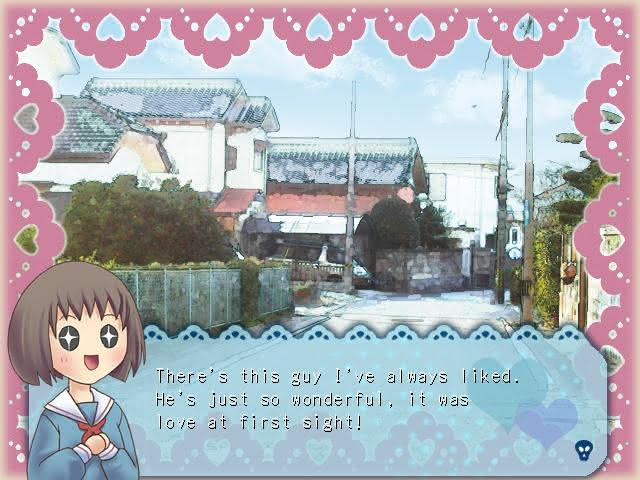
Who is she in love with? That is for the player to decide with a choice that comes very soon after starting the novel.
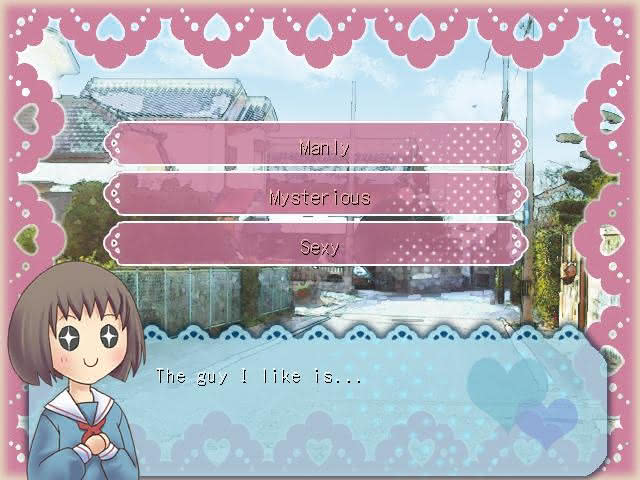
While many novels with meaningful choices lead with an inconsequential choice (see e.g., My Black Cat), The Boy I Like? branches from the very first choice. For example, choosing manly vs mysterious is decisive in that each one leads to a different crush and different route.
Mofuko has her crush after the first choice. The story-line (if we can call it that) proceeds on that route until another choice, which is also decisive. Two of the three routes have only a single choice point branching into two endings. One of the route has two separate choice points and three endings (the first choice point in that route is survive and advance so to speak with one option resulting in an ending and the other option continuing to the second choice point).
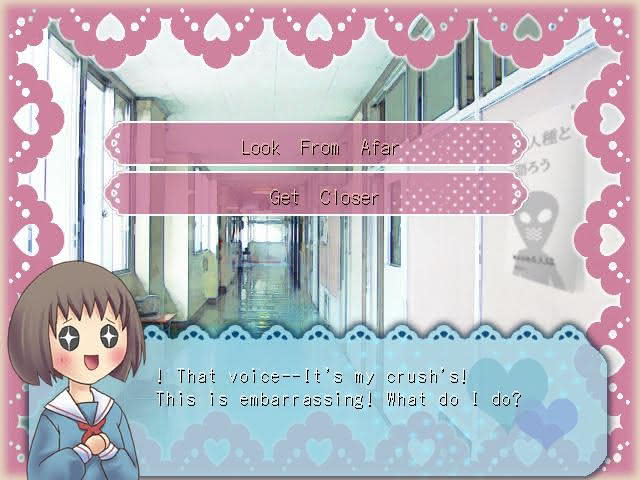
Despite having a total of seven endings, The Boy I Like is a very short visual novel. The aggregate user-reported time estimate on Visual Novel Database is 19 minutes and that to me sounds about right provided the player creates save points on each choice prompt.
The Boy I Like? has some unique visual flourishes that set it apart from the standard-issue NScripter visual novel. The entire edge of the screen has a frilly pink lace border. Mofuko’s portrait occupies the bottom-left corner of the screen in a style reminiscent of Red Shift. If there is another character in the scene, he usually occupies center-stage, overlaying the background. Mofuko has one named friend among her classmates who plays a role in two of the three routes – usually trying, unsuccessfully, to steer her strange friend down the correct path – but said friend does not have a portrait (she apparently receives one in the sequel).
The novel uses a text box instead of running text over the entire window. The text box is blue with a frilly border on its top – this serves to set it apart from the window border. I also noted that the text cursor in the bottom right appears to be an alien head – a flourish that proves to not be entirely random. There is some odd symbol and punctuation placement next to character names in dialogue, but this did not affect readability.
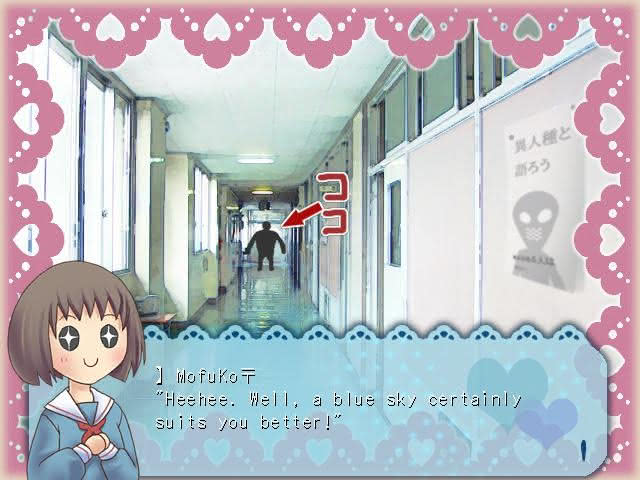
Mofuko’s portrait is flat and cartoonish but very expressive – conveying her dense dreaminess. The backgrounds are heavily modified photographs but more work went into them than the norm for NScripter novels with photographic backgrounds. I will single out a shopping district background as being the best of the bunch.
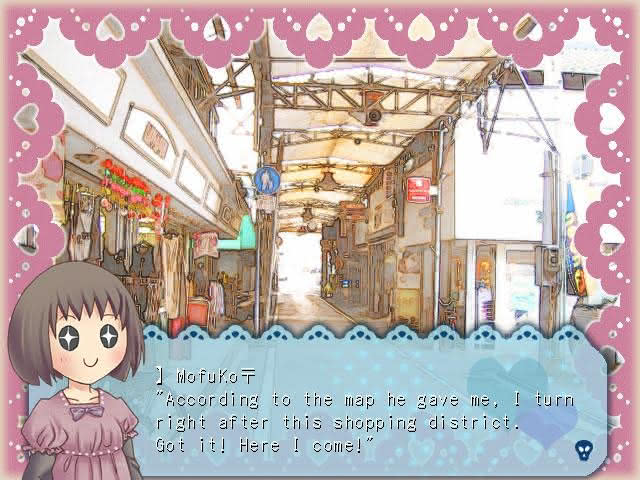
One minor visual complaint I have regards the dialogue. The novel, at least out of the box, uses a thin, white font which, against the pale blue text box, most likely falls short of the best accessibility practices. I have good eye sight and never had difficulty reading, but it does not make for a pleasant reading experience. I think it is possible to change fonts but that is a bit beyond my current ONScripter-EN competence.
The novel has a few CG-scenes including different ones for most of the endings. At least one of the routes includes a few effects for one of the three love interests that go beyond the standard portrait.
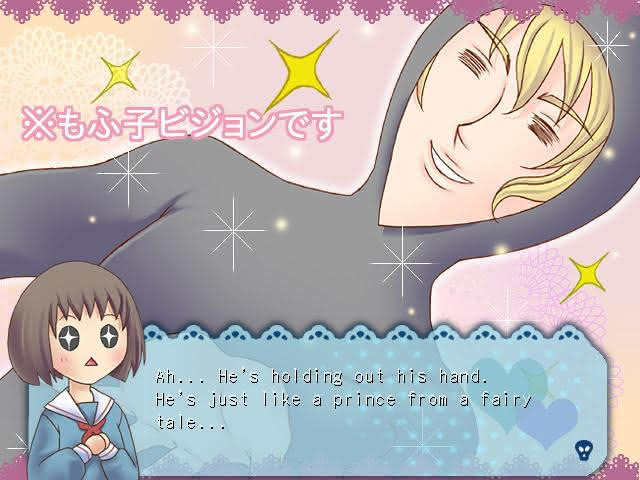
The novel has a standard NScripter load screen exempting the color and border UI elements. It provides 10 save slots, but I can confirm that this is more than enough to keep a bookmark on every decision point in the novel.
One minor disappointment is that there are no extras in the form of a CG gallery or a menu keeping track of all of the seen endings (see e.g., Night of the Forget-Me-Nots for an ending gallery example).
I preface my discussion of the translation as always by noting that I do not read Japanese and have not read the original Japanese novel. Thus, my translation assessment solely concerns how the novel reads in English and not its fidelity to the original script. I can happily report that The Boy I Like! reads very well in English – as smoothly as some of the better al|together pieces I have reviewed. I do not analyze novels line-by-line but instead keep tabs on any lines that I find particularly jarring. I had a fairly long list for one of my more recent reviews covering Boku no Shokora, but The Boy I Like? demanded no such efforts. While I doubt that the original Japanese was too technically demanding by visual novel translation/localization standards in light of the fact that the script is very short and all of it is a joke – but I tip my hat to kudaratan for a job well-done.
My impressions of the content of said good-reading script are decidedly more mixed. I do not recall having ever quoted a Visual Novel Database review on site but there is a first time for everything – so I quote in part from reviewer yamawagon, who gave the novel an 8/10:
I am a memer … but this is completely new level. This game is super cursed, so cursed that my brain died few times, but to be honest, its really funny…
The novel gives off the distinct vibe of having been created by someone who is fluent in image board memes. It did not escape my notice that the original novel was published in Japan on April Fools, which may not have been a coincidence notwithstanding the fact that April Fools is not particularly popular in Japan. It is drenched in absurd humor from beginning to end. The starry-eyed Mofuko has comically horrible taste in love interests and is impervious to reason – with there being only a single example of her being distracted?/removed from her love-struck reverie. Two of her love interests are somewhat disordered (to put it mildly) and the other defies easy categorization.
The Boy I Like? is the case of something that can be charitably described as an acquired taste. Memer yamawagon acquired the taste. Did I? Not quite. Without spoiling the content of the routes, I thought the Mysterious route was funny. The initial set-up is absurd and both of its endings elicited a chuckle not only for the humor but for subverting my expectations that I had based on the nature of the love interest. I did not care much for the Manly and Sexy routes, both of which featured love interests with profound issues. The Sexy route had some individually amusing lines by said love interest (I will venture these lines required the most localization competence), but the entire thing felt pointless even for a game that does not have much point. The hero of the Manly route is too creepy in a very obvious way and absolutely nothing about what is supposed to be its main ending was unexpected. Again – mileage with this sort of game will vary – much like I noted in my review of an earlier meme game that I liked called Crimsoness, but only the Mysterious route clicked for me in this particular novel.
While I turned out to not be the right audience for The Boy I Like?, I did like its choice structure if not the boys. Giving the player three different boys, each based on how Mofuko describes her love interest in the first choice, was a clever set-up, and so too were the endings stemming from one (or in one of the three cases, two) additional choices.
Conclusion
I originally selected The Boy I Like? for review after finding it on Kaisernet’s list of ONScripter-EN visual novels and taking an interest in the way its English patch is applied. I was ultimately undecided about reviewing it after reading – but I decided to publish the review because the novel is an interesting historical curiosity and the technical notes are an interesting addition to my writings on ONScripter-EN.
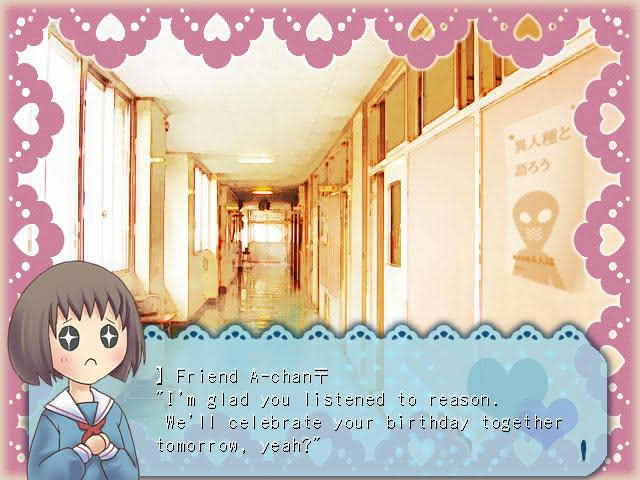
It should go without saying that I would not recommend The Boy I Like? as a general matter – but people who read my review of Crimsoness and subsequently enjoyed the novel may like it – granting that I enjoyed Crimsoness much more than The Boy I Like? People who are familiar with the al|together 2006 translation of OMGWTFOTL, which I did not review in full but included in my al|together ranking, may also enjoy it (for whatever it is worth, I think The Boy I Like? and OMGWTFOTL are in the same general tier). Finally, it is worth a look for people who are interested in English translations of doujin novels as a general matter and for anyone who is specifically interested in visual novel choice structures. The top technical merit of The Boy I Like? is in how it used just five decision points to naturally lead into seven distinct endings in what is ultimately a very short piece.